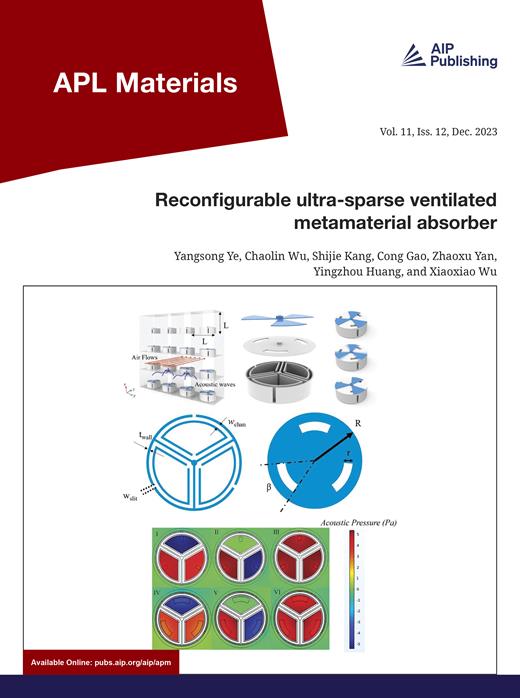Solution-based iron doping of solvothermally grown 2D hexagonal bismuth telluride
IF 5.3
2区 材料科学
Q2 MATERIALS SCIENCE, MULTIDISCIPLINARY
引用次数: 0
Abstract
In this work, we examine the formation of iron-based magnetic domains on two-dimensional (2D) single-crystal bismuth telluride plates. Using solvothermal chemical methods, 2D bismuth telluride (Bi2Te3) single crystalline nanoplates were reacted with iron salts (FeCl2) to achieve electrical doping. The use of a reducing agent [L(+)-ascorbic acid] along with FeCl2 resulted in homogeneous dispersion of iron across the crystal, whereas non-reduced iron doping achieved edge growth of iron/iron oxide nanoparticles. High-resolution analytical electron microscopy was used to examine the iron nanoparticle accumulation and morphology at nanoplate edges for non-reduced materials and iron dispersions within the crystals in the case of reduction. Our analysis revealed little variation in the atomic uptake of iron in any form over a range of solution-dopant concentrations. However, structural analysis and transport measurements clearly indicate the tendency of the dopant nanoparticles to oxidize quickly. The Seebeck coefficient and power factor also express modifications with exposure to oxidation, providing an indirect probe of the dopant modification to the host Bi2Te3’s electronic properties. Importantly, however, magnetic force microscopy images show a distinct difference in the formation of magnetic phases with and without the use of reducing agents during iron doping. This suggests that oxidation post-doping does not form magnetic phases, whereas oxidation during the doping process is suitable for obtaining magnetically doped Bi2Te3 nanocrystals.基于溶液的铁掺杂溶液热生长二维六方碲化铋
在这项工作中,我们研究了二维(2D)单晶碲化铋板上铁基磁畴的形成。利用溶热化学方法,二维碲化铋(Bi2Te3)单晶纳米板与铁盐(FeCl2)发生反应,以实现电掺杂。在使用氯化铁的同时使用还原剂[L(+)-抗坏血酸]可使铁在晶体中均匀分散,而非还原铁掺杂则可实现铁/氧化铁纳米颗粒的边缘生长。我们使用高分辨率分析电子显微镜检查了非还原材料纳米板边缘的铁纳米颗粒堆积和形态,以及还原情况下晶体内的铁分散情况。我们的分析表明,在溶液掺杂浓度范围内,任何形式的铁原子吸收变化都很小。不过,结构分析和传输测量结果清楚地表明,掺杂纳米粒子有迅速氧化的趋势。塞贝克系数和功率因数也会随着暴露于氧化环境而发生变化,从而间接探测掺杂剂对主 Bi2Te3 电子特性的改变。但重要的是,磁力显微镜图像显示,在铁掺杂过程中,使用和不使用还原剂形成的磁相存在明显差异。这表明,掺杂后的氧化不会形成磁性相,而掺杂过程中的氧化则适合获得磁性掺杂的 Bi2Te3 纳米晶体。
本文章由计算机程序翻译,如有差异,请以英文原文为准。
求助全文
约1分钟内获得全文
求助全文
来源期刊

APL Materials
NANOSCIENCE & NANOTECHNOLOGYMATERIALS SCIE-MATERIALS SCIENCE, MULTIDISCIPLINARY
CiteScore
9.60
自引率
3.30%
发文量
199
审稿时长
2 months
期刊介绍:
APL Materials features original, experimental research on significant topical issues within the field of materials science. In order to highlight research at the forefront of materials science, emphasis is given to the quality and timeliness of the work. The journal considers theory or calculation when the work is particularly timely and relevant to applications.
In addition to regular articles, the journal also publishes Special Topics, which report on cutting-edge areas in materials science, such as Perovskite Solar Cells, 2D Materials, and Beyond Lithium Ion Batteries.
 求助内容:
求助内容: 应助结果提醒方式:
应助结果提醒方式:


